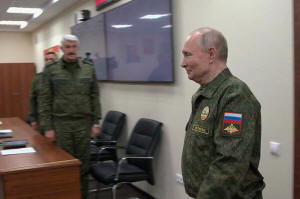Putin brandishes a new nuclear-powered missile as he digs in over
Russia's demands on Ukraine
[October 28, 2025]
By The Associated Press
By holding nuclear drills and boasting about a successful test of a
pioneering atomic-powered cruise missile, Russian President Vladimir
Putin is sending a message to President Donald Trump: Moscow won’t be
cowed into making concessions on Ukraine.
Facing Trump’s call for a quick ceasefire and bruising, new U.S.
sanctions on Russia’s oil industry, Putin is again reminding the U.S.
and other Western allies of Kyiv about his nuclear arsenal to back his
longstanding, maximalist demands.
He has said Ukraine must pull back its forces from the four regions that
Russia has annexed illegally but never fully captured, as well as
abandon its bid to join NATO — demands rejected by Kyiv and its Western
allies.
Here is a look at Russia's new missile and its role in Putin’s nuclear
messaging:
Russia responds to a US missile shield
The Burevestnik, which means “storm petrel” in Russian, is the world’s
first nuclear-powered missile. That propulsion gives it virtually
unlimited range, allowing it to loiter for days, circling the enemy’s
air defenses and attacking from an unexpected direction.
Putin first announced the missile in a 2018 state-of-the-nation address,
along with several other prospective weapons, declaring it would be able
to dodge air defenses.
The development of the Burevestnik, which has been code-named “Skyfall”
by NATO, has continued despite reported launch failures. On Sunday,
Russia’s chief military officer, Gen. Valery Gerasimov, reported to
Putin that an Oct. 21 test of the Burevestnik was a complete success
that proved its capabilities.

The missile covered 14,000 kilometers (8,680 miles) during a 15-hour
flight using nuclear fuel and conducted maneuvers “demonstrating its
high capabilities in evading missile and air defense systems,” Gerasimov
said.
“The technical characteristics of the Burevestnik missile effectively
allow it to be used with guaranteed accuracy against highly protected
targets at any distance,” he added.
While Russian officials have revealed no details about the weapon,
Russian media reports indicated it could cruise at altitudes as low as
50 meters (about 160 feet) to avoid enemy radar.
Putin ordered Gerasimov to prepare the necessary facilities for
deploying the Burevestnik and working out its modes of operation.
The Russian leader has described the weapon as a response to the U.S.
missile shield that Washington has developed after its 2001 withdrawal
from a Cold War-era U.S.-Soviet pact that limited missile defenses.
Russian military planners have feared that a missile shield could tempt
Washington to launch a first strike that would knock out most of
Moscow’s nuclear arsenal in hopes of intercepting a small number of
surviving missiles fired in retaliation.
The Burevestnik, as well as the prospective Poseidon nuclear-powered and
nuclear-armed drone with an intercontinental range that was also
announced by Putin, were presented as means of guaranteed retaliation to
a first strike.
Technological challenges and lingering risks
Unlike a conventional cruise missile powered by jet engines with a range
limited by the fuel it can carry, a nuclear-powered cruise missile has a
practically unlimited range and can loiter for days over the ocean
before streaking to a target from a direction unprotected by missile
defenses.
These unique capabilities involve massive technological challenges and
potential radiation risks -– factors that prompted the U.S. to abandon a
nuclear-powered missile project in the 1950s after viewing it as too
unsafe for its own military personnel and allies.
Many Western experts have been highly skeptical about Russia’s ability
to build such a missile, with some describing it as a “flying Chernobyl”
due to radiation hazards.
A 2019 accident killed at least five nuclear engineers and injured
several others in an explosion that the U.S. believed occurred when
Russian experts tried to recover a Burevestnik prototype that had
crashed into the White Sea during an earlier test. The local
administration in a city near the site of explosion reported a brief
rise in radiation levels.
[to top of second column]
|

In this image made from video provided by the Russian Presidential
Press Office on Sunday, Oct. 26, 2025, Russian President Vladimir
Putin arrives to visit one of the command posts of the Joint Group
of Forces. (Russian Presidential Press Office via AP)

Putin and Gerasimov didn’t say where the missile was tested Oct. 21,
but on that day Russia closed off a large area around the Arctic
Novaya Zemlya archipelago where previous tests of the Burevestnik
had occurred, deploying vessels and aircraft linked to the program
in the area.
The Norwegian Radiation and Nuclear Safety Authority said no
radiation spikes have been reported so far at any of its monitoring
stations, the Barents Observer reported, an indication the
Burevestnik designers could have managed to develop a design
avoiding radioactive contamination.
Putin spoke about the missile with pride in televised comments.
“When we announced that we were developing such a weapon, even
highly qualified experts told me that it was a good and worthy goal,
but undoable in the near future," he said. "And now the decisive
tests have been completed.”
Putin’s nuclear messaging and Trump’s response
Putin repeatedly has brandished Russia’s nuclear might since he
launched the full-scale invasion of Ukraine in February 2022,
declaring that Moscow was prepared to use “all means” to protect its
security interests. He again turned to nuclear messaging now as
Trump has put a planned summit in Budapest with Putin on hold and
declared his first major sanctions against Russia.
Hours after Trump’s announcement, Putin presided over the drills
that involved all parts of Russia’s nuclear triad and featured
practice launches of ground- and submarine-launched nuclear capable
intercontinental ballistic missiles, as well as cruise missiles
being fired by strategic bombers.
The televised images of Putin directing the nuclear exercise
followed similar action by him throughout the nearly 4-year-old war.
He repeatedly warned against Kyiv striking deeper into Russia with
Western supplied weapons or deploying Western troops to Ukraine.
On Monday, Putin also endorsed the Kremlin-controlled parliament's
decision to withdraw from a 2000 agreement with the U.S. on
disposing of vast Cold War-era stockpiles of weapons-grade plutonium
over what lawmakers described as “new anti-Russian steps that
radically change the strategic balance.”
While declaring his readiness to keep talking to Trump about a
prospective Ukrainian settlement, Putin also described the new U.S.
sanctions against Russia’s top oil companies as an “unfriendly act”
that would damage relations. He warned that Russia wouldn’t be
intimidated.

“It’s an attempt to exert pressure on Russia, but no self-respecting
country and self-respecting people make any decisions under
pressure,” he said.
Putin also warned that any attempt by Ukraine to strike deep inside
Russia with longer-range weapons supplied by the West will trigger a
“very serious, if not to say stunning,” response from Moscow. Three
days later, he donned military fatigues to receive a report on the
Burevestnik’s successful test launch.
Trump responded Monday with irritation when asked about the test.
"You’ve got to get the war ended, a war that should have taken one
week is now in its soon fourth year. That’s what you ought to do,
instead of testing missiles,” he said.
He added that “we have a nuclear submarine, the greatest in the
world, right off their shores,” and so “we don’t need to go 8,000
miles.”
—-
Chris Megerian aboard Air Force One contributed.
All contents © copyright 2025 Associated Press. All rights reserved
|